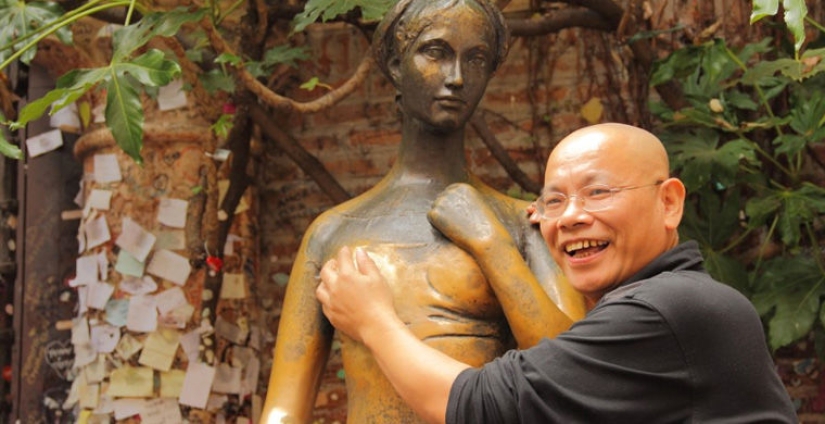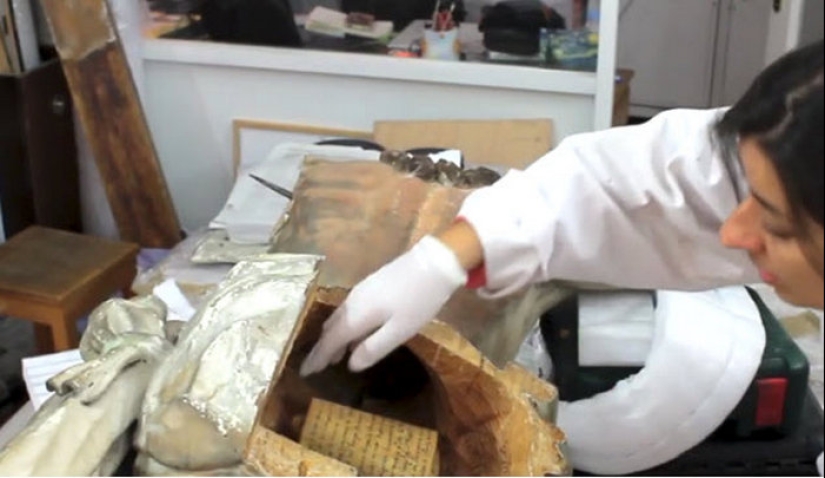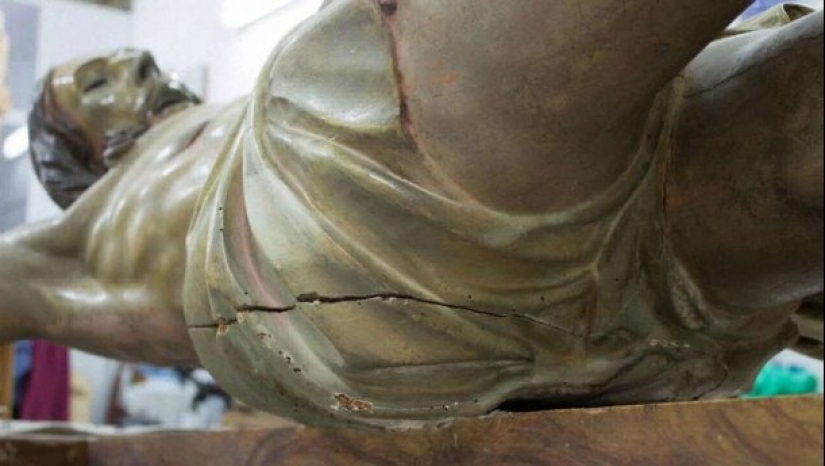10 interesting finds made inside the statues
Categories: Culture | History | Science | World
By Pictolic https://pictolic.com/article/10-interesting-finds-made-inside-the-statues.htmlSculptures created by real masters are, if not artistic, then certainly of historical value. Despite this, scientists sometimes have to break the integrity of the figures, as something more valuable than the work itself may be hidden inside. Such finds are infrequent, but they almost always carry important discoveries.

An unexpected find was made by restorers from the town of Saint-Ageda, Spain. Inside one of the statues that decorated the local temple for 240 years, ancient scrolls with records were found. They were located in an unusual place for artifacts – in the buttocks of the Savior.
On two parchment scrolls were the notes of a certain Joaquin Minguez, a priest who served in the cathedral of Burgo de Osma in the second half of the XVIII century. In 1777, the holy father decided to describe the history of the creation of the figure, as well as some events from the life of the townspeople.

From the scrolls, scientists learned that the statue of the crucified Jesus was created by master Manuel Bal, who made figures for many temples in Spain. Minges also talks about the good harvest of wheat, rye, oats and barley, as well as the abundance of wines in the bishop's cellars.
Some adversities were also described. In particular, the priest told about the typhus epidemic that swept the province, because of which the clergy were forced to sit in monasteries and pass the time playing ball and cards. In conclusion, the author recalls that he writes during the reign of King Carlos III, whose residence is in Madrid.

After checking the church archives, it turned out that such records are stored in the temple among other scrolls from different eras. Why the author decided to hide additional copies in such an unusual place, history is silent. After the scrolls were thoroughly examined, their copies were returned to the buttocks of the statue, and the originals were handed over to the archbishop of Burgo de Osma.
In 2016, when examining one of the exhibits of the auction – a 645-year-old wooden head of the Buddha, art historians from Australia found a cavity inside, in which there was a banknote. It was much larger than modern banknotes – almost the size of a standard A4 sheet.

The note said it was issued in 1371, during the reign of Zhu Yuanzhang, the first emperor of the Ming Dynasty. Its face value, 1 guan, was equal to 1,000 copper coins or 28 grams (1 ounce) of pure silver. Interestingly, along with the denomination and other important information, the banknote had an inscription calling on the authorities to report cases of counterfeit banknotes and reminding them that this crime is punishable by beheading.
This discovery was a real event in archaeology, as the banknote was recognized as the very first known example of paper money in history. It is known that in Europe, paper money began to appear 300 years later, in the XVII century. It is surprising that in six centuries, no owner of the item has found a hiding place in it. The banknote was put up for auction in a separate lot and successfully sold.
In 2014, during the restoration of the wooden statue "Humility of Christ", depicting the waiting crucifixion of Jesus, human teeth were discovered. The fact that the 300-year-old figure was equipped with real teeth was not a discovery, since in Mexico they like to attach claws, teeth and hair to iconic sculptures. But all these details, except for the hair, belonged to animals: dogs, rabbits and foxes. In the same case, human body parts were used.

Scientists were also surprised by the fact that the find did not carry any aesthetic function, since it was located behind the tightly closed lips of the figure. The teeth were in perfect condition-they were taken from a living or dead person who wanted to immortalize himself in the statue of the Savior. In the seventeenth and eighteenth centuries, it was fashionable among Mexicans to bequeath parts of their bodies to the church.
Located in one of the temples of Bangkok, the 2.7-meter-high Buddha statue, bearing the intricate name Phra Phuttha Maha Suwan Patimakon, is known to many Thais. It was never considered valuable, as its surface was just ordinary plaster. The Buddha was made in India in the XIII or XIV century and it came to the capital of Thailand in 1801.

At first, the figure was located in the Wat Chotanaram temple, and then, in 1935, it was transferred to Wat Traimit. There was no place for a large statue under the roof, and for many years it stood in the courtyard, under a specially made canopy. In 1955, the Buddha was again wanted to be moved to a new location, but it was accidentally dropped during loading. Under the ancient cracked plaster, the astonished workers and monks saw 18-karat gold.
All this time, a statue made of precious metal was hidden under a layer of clay. The figure consisted of 9 parts and a key was attached to it, with which it was easily disassembled and assembled. Historians suggest that the Buddha was plastered to hide its true value in the 17th century, when the Burmese invaded India.
In 2018, a 76 cm high bodhisattva statue was found in the Hokkeyoji Temple in Nara, Japan. The find was about 700 years old and depicted Monju Bosatsu, the bodhisattva of wisdom. Traditionally, he is depicted sitting on a lion, representing the harnessed mind, with a book in one hand and a sword in the other.

When examined by a tomograph, a cache of 180 items was found in a relatively small figure. 150 of them were in the bodhisattva's body, and 30 were in his head. Among the finds were scrolls with texts, ritual objects and other artifacts. So far, the finds have not been extracted, so no one knows what is written in the ancient documents found.
In the Italian city of Verona, where the actions of Shakespeare's tragedy "Romeo and Juliet" took place, in 1969, a statue was erected to the heroine of the sad story. This figure has become a place of pilgrimage for tourists who touch it and ask it to give them happiness in their personal lives. Constant contact with the hands led to significant wear of the surface, which required the intervention of specialists.

In 2015, the girl was taken for restoration and was surprised to find that it was filled with letters and keys from locks. As it turned out, the figure, cast in bronze, had long ago given several cracks and in them the guests of Juliet began to throw letters with wishes and keys to padlocks, embodying the inviolability of family ties.
Everyone knows that drug cartels are inventive, inventing new ways to transport drugs. In 2010, police in Colombia seized copies of the World Cup made from 11 kg of cocaine. Craftsmen mixed the powder with acetone and gasoline, and then cast the product in a mold and covered it with paint.

American customs officers were also lucky to intercept a statue of Jesus made of 3 kg of cocaine en route from Mexico to Dallas. Both in the first and in the second case, service dogs helped to detect prohibited substances in the composition of crafts.
In the 1990s, an ancient Buddha statue was found in China, inside which was the skeleton of a monk. Studies have shown that the body was mummified in the X century, and it was placed in the statue a little later. Buddhist monks used a special method of mummification, starting to prepare for death in advance.

Three years before the chosen date, the monk switched to a special diet of plant foods: berries, nuts and tree bark. Shortly before the burial, the monk completely refused to eat, consuming only salt water and continuously meditating. So the man slowly faded away, and when his fellows saw that he was on the verge of life and death, he was still buried alive.
After certain intervals of time, the body was removed and checked for its safety. Not every time it was possible to get a mummy, so preserved bodies are rare. As for the mummy in the statue, this case can be considered unique.
In the American city of Orlando, Florida, there was a 363-kilogram monument to Johnny Reb-a Confederate soldier. The figure of the fighter constantly caused discontent of the black population, as according to local African Americans, it reminded of slave owners and racial discrimination.

In 2017, scandals and lawsuits bothered the local authorities and the statue was decided to be dismantled. At the base of the figure was found a metal box, which contained flags and banknotes of the Confederacy, as well as newspaper clippings from the second half of the XIX century. The find was transferred to the museum, and the monument was installed in the local cemetery at the grave of 37 Confederate soldiers.
In 2014, during the reconstruction of the Old Capitol in Boston, a time capsule was found in the gilded figure of a lion that decorated the roof of the building, laid at the turn of the XIX and XX centuries. It was not difficult for researchers to find a mention of this cache in the city archives.

The Boston Globe in 1901 described the capsule and the process of laying it down for future generations of Bostonians. The creator of the lion and his assistants hid a container in the head of the figure, in which newspaper clippings, autographs of famous people in the city, photos and even several letters to descendants from the residents of the city were sealed.
After getting acquainted with the contents of the capsule, it was supplemented with new materials of the XXI century and again laid in the head of the statue, this time for the residents of the city from the XXII century.
Keywords: Culture | Science | History | World | Sculptures | Monuments | Capsule | Buddha | Antiquities | Cache
Post News ArticleRecent articles

Twitter user @FactBuffet collects interesting facts about everything. Today we bring to your attention another series of facts that ...

Aomori Prefecture in the north of the Japanese island of Honshu is an agricultural region famous for its delicious apples. In ...
Related articles

Compared to the 1970-ies 1980‑e years were a time of cautious optimism in new York. Boom on wall street fueled the speculative ...

What kind of wedding traditions do not happen! The Scots pour dirty slush over the bride, some peoples of India have decided to get ...

Many are tormented by the question — why do some grow long nails on his pinky. If you ask the owners of such "decorations", we ...

Imagine a baby vampire or a tiny zombie with glass eyes ... An artist from the USA Bean Shanine specializes in creating such ...